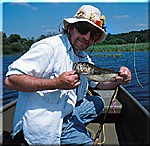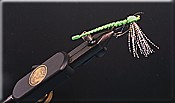
In the middle of a blazing-hot day, my fishing partner and I are drifting along the edges of fields of lily pads. Bob is flipping jigs into openings and pockets in the pads, but the bass aren't cooperating. Worse, the fish are leaping all over the place. There's a loud splash every few seconds as a bass rockets out of the water and falls back. Some fish are leaping quite close to the boat, and others put on their little show way back in the weeds.
The deer-hair popper I've been casting draws no interest from the bass. On one cast, the popper lands in a pocket the size of a shoe box. The ripples barely subside before a big bass blasts out of the pocket, knocking the popper high in the air. This happens twice before I notice the dragonflies hovering over the pads.
There's something about dragonflies. Bass hate them. Or maybe love them as delicious snacks. Whatever the reason, the bass start jumping when dragonflies or damselflies gather over fields of aquatic plants, the bass start jumping. It's a sight that will get anglers' hearts thumping, too. Unfortunately, it can also be one of the most frustrating situations a bass angler can face.
In The Air
When I finally realized what was happening on the sweltering summer day, I also realized that I didn't have any dragonfly imitations with me. I dug frantically through my fly boxes, looking for something, anything, that could get one of those fish to bite.
Meanwhile, Bob was also digging through his tackle box. He went from the jig he was flipping to a plastic worm. The worm didn't work, so he tried a weedless frog. The fish kept leaping, goading us on.

Having inventoried my fly boxes, it was clear that an accurate dragonfly imitation didn't make it into the collection that day. But I did come across a couple of ratty Muddler Minnows. If I squinted hard, the Muddlers sort of looked like dragonflies. There was nothing to lose, so I tied one on and applied a dollop of floatant to its spun deer-hair head.
I made a short cast to a small opening in the pads. The fly landed gently, and I gave it a slight twitch. The water exploded as a bass engulfed the Muddler. It was the first of many fish I caught that day. Bob, unfortunately, went fishless. The bass wanted dragonflies and would eat nothing else.
Since that day, I've made it a point to always carry at least one small box with some dragonfly patterns. I've developed quite a collection since then. Some are rather exacting imitations, and others are pretty crude. They all catch fish.
Green Trout?

In some parts of the South, they call largemouths green trout. And there are times when that name is very appropriate. Real trout, of course, are known for being "selective." This means that the fish will eat only one thing--a specific species of mayfly that is hatching, or a specific kind of nymph--and they'll ignore every other kind of food.
But a dragonfly imitation would be gobbled up as soon as it landed in a clear opening. There are plenty of magnificent dragonfly and damselfly patterns out there. Many are so lifelike that they fudge the line between lure and bait. And many of these super-realistic imitations take time and effort to tie.

Happily, I've found that the bass are just as satisfied with something that approximates a dragonfly. That's why those Muddler Minnows worked that hot summer day. So, my dragonfly imitations now tend to be rather minimalist. I lash a strip of closed-cell foam to the hook so that it's pointing out over the eye of the hook. Next, I tie in the wings: either a few strands of Krystal Flash tied cross-wise on the hook, or a couple of grizzly hackles tied in the same way. Once the wing is tied in, the foam gets folded back over the hook to make the head of the fly. I leave a long foam stem hanging off the back of the hook, and spiral some thread around that stem, and the fly is essentially complete.
These flies are very simple to tie, and I can whip out a dozen in an hour. This makes them great for fishing in the most tangled lily-pad fields. I can cast anywhere and not worry about losing the fly. Best of all, the fish really go for them. Few things are more thrilling than having a giant bass leap clear out of the water as it hammers your fly.
John Likakis is the editor of Warmwater Fly Fishing, the magazine for those serious about catching bass with a fly rod.



